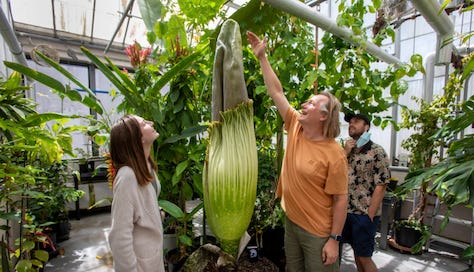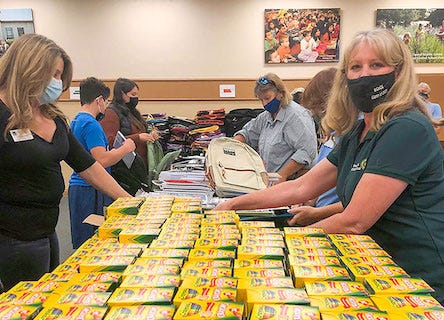This Week on the Central Coast...
Carmel planned a future with renewable energy, Stuff the Bus provided students-in-need with supplies, and a rare Corpse Flower bloomed at UCSC
Carmel’s Climate Action Plan going into effect
At this week’s city council meeting in Carmel-by-the-Sea, the Climate Adaptation and Action Plans were discussed extensively. The plans are being implemented by Central Coast Community Energy (3CEnergy). The company hopes to achieve 60% renewable energy by 2025 and 100% renewable energy by 2030. This would put Carmel fifteen years ahead of the state’s goals.
Changes have already begun to happen with the purchase of an electric street sweeper and the city plans to coordinate with PG&E to develop more charging stations at city buildings.
The Climate Committee has a range of planned actions to address the various climate-related dangers in our community, such as fires, droughts, and rising sea levels. The plans cover a broad spectrum of time and money, ranging from almost no money to implement and taking place within the next year or two, to requiring over $100,000 and over ten years to complete. The full Climate Adaptation Plan is available on the city’s website.
Monterey’s Stuff the Bus helps students in need
United Way of Monterey County’s 12th annual “Stuff the Bus” donation event collected over 4,500 backpacks full of school supplies.
The backpacks, stuffed with paper, pencils, binders, and other essentials, were distributed to “students living in homeless or near-homeless conditions in the county.” United Way’s president said that students experiencing homelessness in Monterey County has increased over the past 12 years and was only worsened by the pandemic.
United Way’s website has plenty of information about donating and their background in finding ways to create financial stability for families in need.
UCSC’s rare corpse flower finally bloomed
The rare, 5-foot-tall corpse flower that has been housed and cared for at UCSC finally bloomed. The arboretum staff had all but given up hope on it when the flower finally opened on Monday night.
The flower gets its name from his signature stench, which the arboretum’s Executive Director described as “like a dead cow rotting. But covered with feces and a few buckets of vomit.” Much of the staff found irony in the fact that such a terrible smell would attract so many people.
Corpse flowers are picky plants and only bloom when enough energy has been stored. This means that the timing can vary from plant to plant. Some take a couple years while others, like the one at UCSC, could take up to a decade.
The corpse flower has since gone back into the greenhouse at the arboretum where staff hand-pollinated it in hopes of producing seeds. In a few days, the flower will die and be reduced to a small bulb underground.
For anyone who missed the event, UCSC’s arboretum staff mentioned that only the first bloom takes a long time; the next one should only take up to five years to bloom again.
If you enjoyed this week’s newsletter, please consider sharing it! It really helps The Peninsula Report grow.






